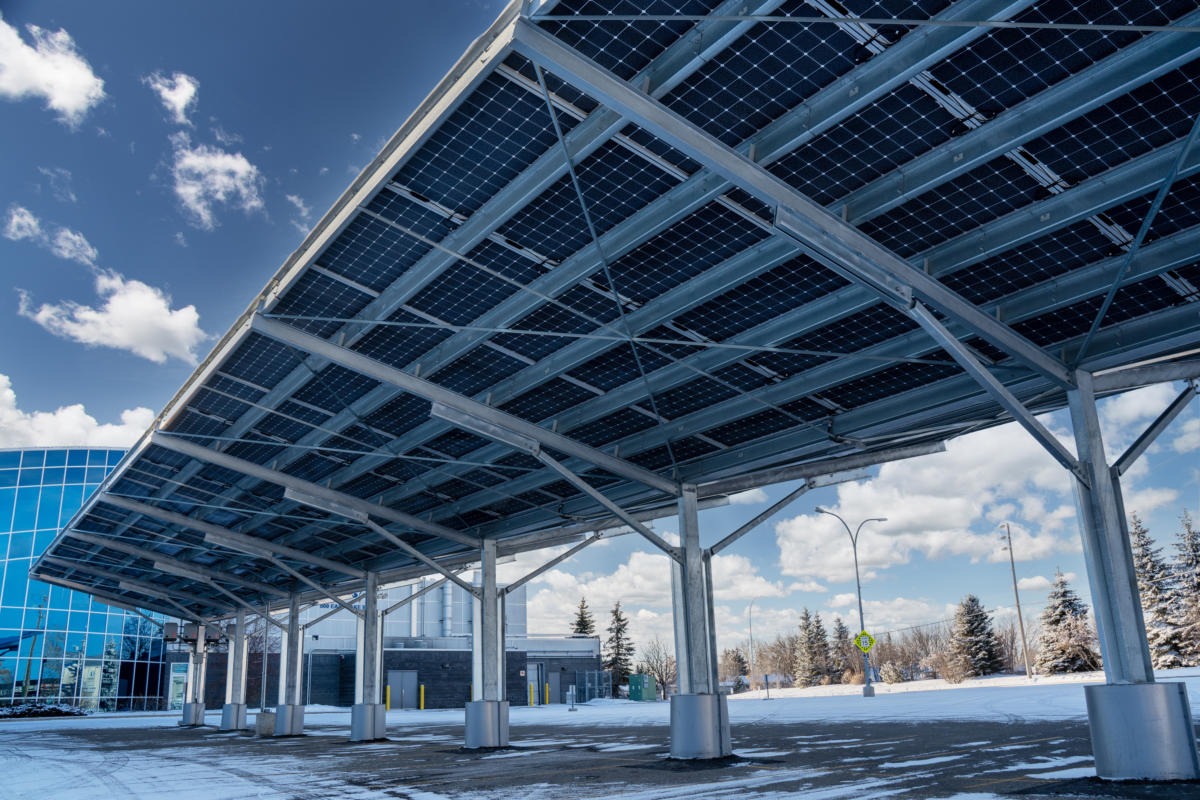Note: this story was updated for clarity on 7-12-21.
A prolonged power outage strikes Greeley, Colorado, but local car dealership Ehrlich Toyota is humming along as usual. Salespeople fill out and print quotes, the finance manager creates contracts, and mechanics provide maintenance services, lifting cars, completing repairs and returning the vehicles to their waiting owners.
After flawless service, an electric car owner drives through the darkened town and pulls into her driveway. It will be a busy day tomorrow, so she parks her vehicle under her carport, plugs it in and walks into her warm home for a relaxing evening.
How are these scenarios possible? They both illustrate the power of solar carports when combined with batteries to alleviate the effect of prolonged power outages on businesses and homeowners. 
What is a solar carport?
As their name implies, solar carports are canopies with cars stored underneath and built-in solar panels on the roof. They’re designed as a protective shade structure for vehicles that also provides solar energy to nearby commercial or residential properties.
The above scenario is imaginary but represents actual instances in which Ehrlich Toyota remained operational during the prolonged power outages that affect Greeley two to four times in a typical year. The car dealership’s resilience is due to the renewable grid-tied hybrid power system installed at Ehrlich Toyota — a 368 kW custom solar carport and 228 kWh battery and controls system designed and built by IPOWER Alliance and L4 Construction and modeled by Ageto Energy.
Thanks to the system, the dealership can now island power from the utility and run indefinitely during the day on solar and storage and for several hours without sun. The solar carport further boosts financial resilience by protecting inventory from hail and reducing snow removal costs.
Solar carports are similar to ground-mounted solar panels. Both provide solar power. Both are oriented at the best angle for optimal sunlight. Both can be integrated as an energy plus storage system or used to power an electric vehicle (EV) charging port.
The advantage of solar carports is their placement: They don’t take up additional land, which uses space more efficiently.
Unlike roof-mounted systems, these solar panels are integrated into the structure’s design and won’t need to be removed when the roof requires significant repairs or replacement.

UL Solutions HOMER Grid is a market-leading solar-plus-storage software tool for designing grid-tied distributed energy systems. With an integrated utility tariff database and a new module for electric vehicle charging stations, it optimizes peak shaving to help commercial and industrial utility customers lower their demand charges. HOMER Grid can model projects with wind and combined heat and power as well as islanded systems, helping users improve their resiliency. Explore your opportunities with HOMER Grid during a complimentary trial. Learn more and download your complimentary trial.

The lead into this article is confusing as it is not just the 368 kW custom solar carport, but also the 228 kWh battery and controls system designed and built by IPOWER Alliance and L4 Construction that is installed at Ehrlich Toyota. The situation wasn’t imaginary, as they have sailed through several power outages including two on Black Friday. Both large solar and batteries work together to provide the resilience.
Thank you for your comment, Diane. You make a good point that the article’s lead, as originally written, was not clear. We updated the headline and some of the text to clarify that storage is a key component in the Ehrlich Toyota system and to credit the companies responsible for this successful installation. The full detail of the Ehrlich Toyota project was published in an earlier Microgrid News article, which is linked to from this article and can be found at https://microgridnews.com/the-need-for-operational-resilience-drives-microgrid-innovation/. We appreciate the feedback!